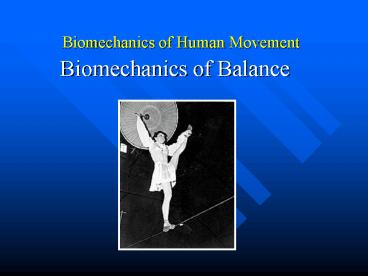Biomechanics of Human Movement - PowerPoint PPT Presentation
1 / 31
Title:
Biomechanics of Human Movement
Description:
Applications Relating to Biomechanics of Balance ... of Pathology and Injury on Balance. Falls.Influence of Pathology on ... of Pathology and Injury ... – PowerPoint PPT presentation
Number of Views:404
Avg rating:3.0/5.0
Title: Biomechanics of Human Movement
1
Biomechanics of Human Movement
- Biomechanics of Balance
2
Biomechanics of Balance Topics
- Applications Relating to Biomechanics of Balance
- Determinants of Stability
- Factors Influencing Stability
- Role of Sensory Input in Balance
- CNS Strategies for the Maintenance of Balance
- Enhancing Balance
- Assessment of Balance
3
Biomechanics of BalanceApplications
- Incidence of Falls
4
Biomechanics of BalanceIncidence of Falls
1.8 million falls among elderly result in medical
treatment 1/3 of all Community-dwelling adults
experience at least one fall yearly Sixth
leading cause of death in over 65 age group
5
Biomechanics of BalanceApplications
- Incidence of Falls
- Economic Impact of Falls
6
Falls..Economic Impact
16.4 Billion Dollars annually Average cost per
fall - 9400 48 of cost paid by Medicare
7
Biomechanics of BalanceApplications
- Incidence of Falls
- Economic Impact of Falls
- Influence of Pathology and Injury on Balance
8
Falls..Influence of Pathology on Balance
Head Injury
Stroke
Vestibular Dysfunction
Orthopaedic Joint Injury
Parkinsons Disease
Alzheimers Disease
Degenerative Joint Disease
Muscle Atrophy
Diminished Balance
9
Biomechanics of BalanceApplications
- Incidence of Falls
- Economic Impact of Falls
- Influence of Pathology and Injury on Balance
- Relationship between balance and posture
implications
10
Balance Influence on Posture
11
Biomechanics of BalanceApplications
- Incidence of Falls
- Economic Impact of Falls
- Influence of Pathology and Injury on Balance
- Relationship between balance and posture
implications - Sport Considerations
- Performance
- Injury Prevention
12
Biomechanics of BalanceSport Considerations
Performance
Injury Prevention
13
Biomechanics of BalanceWhat Causes Instability?
- Destabilizing External Torques Act on Segments
- Gravity
- Distribution and Position of Mass
- Inertia
- External Forces
14
Biomechanics of BalanceWhat Produces Stability?
- Stabilizing Internal Torques Act on Segments
- Muscle Forces
- Ligament forces
- Distribution and Position of Mass
- External Forces
15
Biomechanics of BalanceStability
Stability is Maintained as long as the
Internal (Stabilizing) Torques External
(Destabilizing) Torques
16
Biomechanics of BalanceFactors Influencing
Stability
In Practical Terms Sensory Factors Motor
Factors Biomechanical Factors Size of the
base of support Height of the COG above the
base of support Mass
17
BiomechanicsCenter of Gravity
- Definition The point around which the mass of
the body is equally distributed
18
BiomechanicsCenter of Gravity Factors
Influencing
- Mass
- Location of Mass position of the body segments
- Added (external) mass
19
Biomechanics of BalanceControl of Balance
CNS
Motor
Sensory
20
Biomechanics of BalanceSensory Input
Purpose To provide the CNS with information
about the direction and magnitude of
De-Stabilizing Torques To monitor the effects of
Internal Stabilizing Torques
Components Vision Somatosensory Vestibular
21
Biomechanics of BalanceSomatosensory
- Muscle Spindles
- Joint Receptors
- Tendon Organs
- Mechanoreceptors
22
Biomechanics of BalanceVestibular System - The
Inner Ear
The Vestibular System provides information about
- Head Linear Acceleration
- Head Rotation (angular accelerations)
- Head Position
23
Biomechanics of BalanceSensory Input and Control
Sensory Input activates reflexes that (in order)
- Activates Supporting Musculature
- Activates Muscle synergies to produce correction
24
Biomechanics of BalanceCNS and Control
The CNS Implements Strategies that are intended
to be selectively applied to various levels of
instability
Quiet Stance maintained by postural alignment,
associated joint stiffness and muscle tone
25
Biomechanics of BalanceThe Ankle Strategy
Minimal Instability the Ankle
Strategy Simple Response Rotation at the
ankle Inverted Pendulum
26
Biomechanics of BalanceThe Hip Strategy
Greater Instability the Hip Strategy More
complex Increased translation of
mass Adjustment at Hip
27
Biomechanics of BalanceThe Stepping Strategy
Maximum Instability the Stepping Strategy
Most complex Multiple segments involved
Slowest
28
Biomechanics of BalanceMuscle Response to
Instability
Muscle Response to Instability Results in a
Distal to Proximal Activation Pattern Gastroc/Sol
eus 90 100 msec Hamstrings 120- 130
msec Psoas 130 140 msec
29
Biomechanics of BalanceCan Balance Be
Improved????
YES !!
Sensory Input CNS Processing Muscle
Output Cognitive Factors
All capable of DegradationorImprovement
(sometimes)
30
Biomechanics of BalanceCan Balance Be
Improved????
Assistive Devices
31
Evaluating Balance
Force Plate

